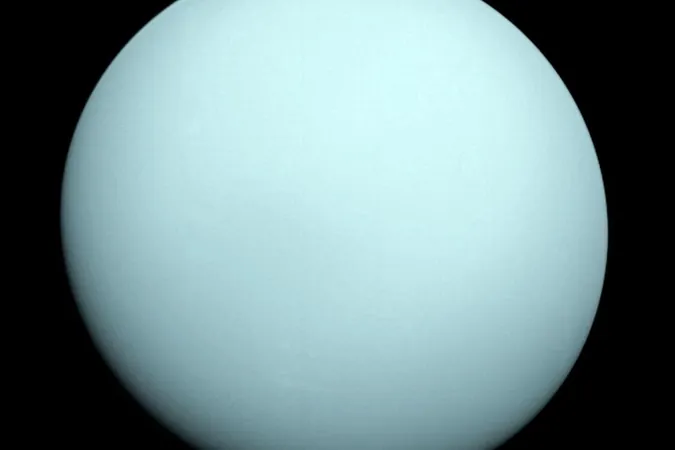
Scientists Reveal Shocking Truth About Uranus’ Magnetic Field – What They Discovered Will Change Everything!
2024-11-11
Author: Rajesh
In a groundbreaking study, researchers have challenged longstanding assumptions about Uranus, the mysterious blue-green planet that has captivated astronomers since its discovery in 1781 by William Herschel. Despite being the first planet discovered with a telescope, much about Uranus remains shrouded in mystery even after more than two centuries.
The pivotal moment in our understanding of Uranus came during NASA's Voyager 2 flyby in 1986, which provided crucial data about the planet’s magnetic field. However, new insights reveal that Voyager 2 encountered unusual solar wind conditions during its historic visit, leading to altered observations and misconceptions about the planet's magnetosphere.
Solar wind—a continuous stream of charged particles emitted by the sun—was at its peak intensity when Voyager 2 passed by, compressing Uranus’ magnetosphere to only 20% of its normal size. Jamie Jasinski, a space plasma physicist at NASA’s Jet Propulsion Laboratory and lead author of the study published in Nature Astronomy, explained that such extreme solar wind conditions occur only 4% of the time, meaning that had Voyager 2 arrived just a week earlier, the results would have painted a vastly different picture of Uranus’ magnetic environment.
The misperception created by Voyager 2’s data suggested that Uranus had an unusually low concentration of plasma in its magnetosphere—the region surrounding a planet dominated by its magnetic field—leading scientists to believe that its magnetosphere was devoid of plasma compared to its neighboring giants, Jupiter and Saturn. This confusion persisted as researchers noted the presence of intense belts of highly energetic electrons, a feature not typically associated with such low plasma levels.
Fascinatingly, this new study indicates that Uranus is similar to its solar system counterparts in terms of its magnetosphere, and that its two largest moons, Titania and Oberon, likely exist within this protective bubble rather than outside it as previously thought. This opens the door to exciting new possibilities, such as the potential for subsurface oceans on these moons, which could harbor the ingredients necessary for life.
Uranus, with its striking turquoise hue from methane in its hydrogen-helium atmosphere, spans about 31,500 miles (50,700 km) in diameter—large enough to fit 63 Earths inside—and orbits nearly 20 times further from the sun than our planet. Its unique tilt results in a peculiar rotation that makes it appear to roll along its orbital path.
The implications of this research are profound. It calls into question how we perceive Uranus and its complex atmospheric and magnetic systems. Understanding the magnetosphere could give insights into the planet's rings and moons, and ultimately lead to potential missions aimed at exploring these celestial bodies in greater detail.
As scientists eagerly await further investigations, including missions targeting icy moons like Jupiter's Europa, the quest to understand Uranus deepens. “A future mission to Uranus is crucial to unveiling the secrets of its atmosphere, rings, and moons,” Jasinski emphasized.
This new revelation about Uranus underscores the ever-evolving nature of planetary science and brings us one step closer to understanding not just our own solar system, but also the potential for life beyond Earth. What secrets will Uranus reveal next? The countdown to unraveling more cosmic mysteries has just begun!


 Brasil (PT)
Brasil (PT)
 Canada (EN)
Canada (EN)
 Chile (ES)
Chile (ES)
 España (ES)
España (ES)
 France (FR)
France (FR)
 Hong Kong (EN)
Hong Kong (EN)
 Italia (IT)
Italia (IT)
 日本 (JA)
日本 (JA)
 Magyarország (HU)
Magyarország (HU)
 Norge (NO)
Norge (NO)
 Polska (PL)
Polska (PL)
 Schweiz (DE)
Schweiz (DE)
 Singapore (EN)
Singapore (EN)
 Sverige (SV)
Sverige (SV)
 Suomi (FI)
Suomi (FI)
 Türkiye (TR)
Türkiye (TR)